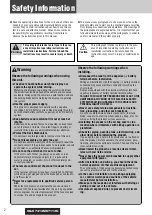
O P E R A T I N G M A N U A L
8 0 0 . 7 4 9 . 2 7 6 1
w w w . c o a c h c o m m . c o m
2 5
•
Dry Pair Testing Fault Screen
– This screen displays the faults found during the dry pair testing. If no faults are
detected the screen will only show the header information with no detail line items listed below. The local pairs (1)
are compared to the remote pairs (2) in a matrix. In Screen A (Figure 31), the system is showing that Pair 1 on the
local unit corresponds to Pair 3 on the remote unit. Screen A also shows that Pair 2 locally is connected to Pair 4
on the remote side of the
system. It also shows that
lines 3 and 4 locally are
connected to 1 and 2 on the
remote end. If there are more
than four lines of errors, the
soft buttons will change to
read “NEXT” and “PREV” as is
appropriate. Use the buttons
under PREV and NEXT to scroll through the
results.
Flexible Combine Module (FCM)
Flexible Isolate/Combine Modules are not provided with X-System, but some customers may still have a Module from a
Tempest NG system. This module allows for the combining or isolating of two intercom lines. For example, if you wish to
have two lines of Offense (i.e., Offense 1 and Offense 2), you may wish for all coaches on the Offensive side of the ball to
occasionally be in one conversation. A remote switch is provided on the end of a cable.
The remote is plugged into the WIM 8(RD) in the appropriate 5 pin XLR jack. When the
switch is activated, the corresponding lines of audio are connected and become one
conversation.
There is a two digit thumbwheel per FCM. These are used to select the two lines that
you wish to combine. While any two lines may be selected, you cannot repeat any line
on both FCMs. For example, if FCM #1 is set to 1 2, then FCM #2 cannot be set to 2 3
since 2 is on both FCMs. This condition will create undesirable audio in the system.
Note:
When any FCM is not in use, it should be set to 0 0 to maximize system
performance. Also, the FCMs should be set to the desired settings prior to
wireless set-up (covered later in this manual).
Ringdown Circuits
The Ringdown Circuits are two conventional telephone circuits completely separate from the intercom system. A customer-
supplied telephone is plugged into the Ringdown Circuit in the Sideline Cart and another in the Press Box Unit. When one
phone is taken “off hook,” the phone on the opposite side rings.
In X-System, the ringdown circuit generators are located in the Sideline Cart and
are therefore on the AC power battery backup in the event of a power failure.
Figure 31: WIM 8 Dry Pair Testing Fault Screen
Figure 32: FCM Remote Switch
Figure 33: Rendering of Ringdown Circuits
















































